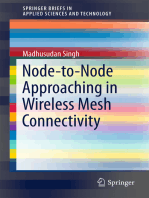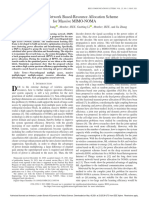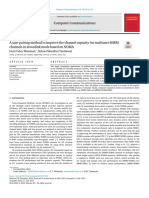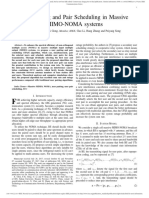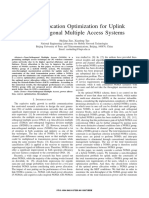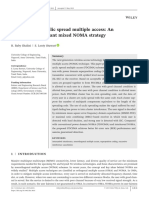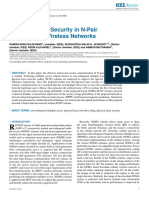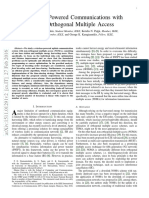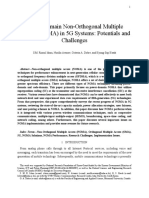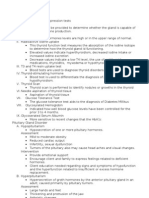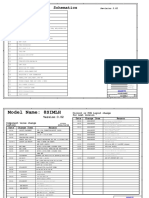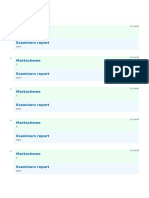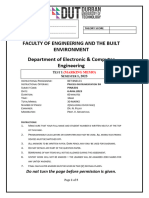Professional Documents
Culture Documents
Dynamic Power Allocation As A Way of Improving The Performance of Users in Non-Orthogonal Multiple Access (NOMA) For 5G Communications
Original Title
Copyright
Available Formats
Share this document
Did you find this document useful?
Is this content inappropriate?
Report this DocumentCopyright:
Available Formats
Dynamic Power Allocation As A Way of Improving The Performance of Users in Non-Orthogonal Multiple Access (NOMA) For 5G Communications
Copyright:
Available Formats
Volume 8, Issue 5, May 2023 International Journal of Innovative Science and Research Technology
ISSN No:-2456-2165
Dynamic Power Allocation as a Way of Improving
the Performance of Users in Non-Orthogonal Multiple
Access (NOMA) for 5G Communications
Mwewa Mabumba, Simon Tembo
The school of Engineering,
Department of Electrical & Electronics Engineering,
University of Zambia, Box 37392, Zambia
Abstract:-In this work the performance of the downlink realised via power domain, code domain and other
non-orthogonal multiple access (NOMA) technique is domains. NOMA offers a lot of advantages as compared to
investigated for two users, that is, cell centre user (user the conventional orthogonal multiple access (OMA) which
c) and cell edge user (user e). The performance of these has been used in the past generations, such as the fourth
users is highly dependent on the power split among the generation (4G). The conventional OMA technology is
data flows and the associated power allocation (PA) limited by orthogonal resources and it is difficult to meet
problem. In this research we propose a power allocation the need of the increasing user number. In NOMA systems,
scheme that ensures fairness for the downlink users Base Stations (BSs) transmit signals via superposition
ensuring improved quality of service (QoS). The system coding at the same time, frequencyand code but with
is analysed based on outage probability which is different power levels relying on successive interference
dependent on the channel state information (CSI) and is cancellation (SIC) performed at the receivers [3], [4]:
compared to the fixed power allocation scheme. The therefore NOMA provides higher spectral efficiency,
simulation results demonstrate the improvement in massive connectivity and low latency as compared to
performance of the users when dynamic allocation is OMA[5]. The users with good channel conditions are
used as compared to the fixed power allocation scheme. called strong users and the others are called weak users.
The weak users are allocated with more power whereas
Keywords:- NOMA, 5G, Power allocation, Outage strong users are allocated with less power for the purpose
probability of improving the user fairness. Weak users decode their
own messages by treating the strong users' messages as
I. INTRODUCTION noise. On the other hand, strong users implement SIC
Non-orthogonal multiple access (NOMA) scheme has technique to decode their own messages by removing the
received significant attention for fifth generation (5G) weak users' messages from the received signal[6]. User
cellular networks in the recent years [1], [2]. NOMA can fairness can be supported by appropriate allocation of
support multiple users within a single resource and thus can power coefficients at the base station. Fig. 1 shows a two
improve user and overall system throughput. It can be user NOMA downlinksystem.
Fig. 1: An example of two user NOMA downlink system
IJISRT23MAY829 www.ijisrt.com 928
Volume 8, Issue 5, May 2023 International Journal of Innovative Science and Research Technology
ISSN No:-2456-2165
II. RELATED WORKS We assume the transmission power is P,𝑆𝑖 is the
message for the users and then the transmitted signal from
User fairness is a very important performance metric the base station can be written as:
of NOMA and has significantly received attention in the
recent years. NOMA raises a critical user fairness issue 𝑥 = ∑𝑛𝑖=1 √𝑃𝛼𝑖 𝑆𝑖 (1)
between cell centre and cell edge users. Fairness can be
supported through appropriate power allocation of the The received signal at user iis given by
superimposed transmitted data flows The user fairness
issues of NOMA are discussed in [4] with instantaneous or 𝑦𝑖 = ℎ𝑖 𝑥 + 𝑛𝑚 (2)
statistical CSI at the base stationand they formulated
algorithms that yield the optimal solution in both cases Where: ℎ𝑖 is the channel coefficient between BS and
considered. The power allocation for NOMA based on user i, 𝑛𝑚 represents the Gaussian noise plus interference.
proportional fairness scheduling is studied for both max-
Following the principal of NOMA the rates for user e
sum-rate and max-min-rate in [7]. A new definition of
and c in downlink NOMA are given by:
fairness which is purely based on information theoretic
grounds in the power domain NOMA wasstudied in[6]. A
𝛼𝑒 |ℎ𝑒|2
reversed relay assisted NOMA considering user fairness 𝑅𝑒 = log 2 (1 + 1 ) (3)
𝛼𝑒 |ℎ𝑒|2 +
was studied in[8]and the considered model analyzed in 𝜌
terms of all key performance indicators (KPIs) like ergodic
capacity, outage probability, and bit error rate with a more 𝑅𝑐 = log 2 (1 + 𝜌𝛼𝑐 |ℎ𝑐 |2) (4)
accurate imperfect SIC model and imperfect CSI. Overall respectively, where: 𝜌 = transmit SNR, 𝛼𝑒 &𝛼𝑐 =
the above studies show that NOMA can improve the user power allocation coefficients for user e & user c, and𝛼𝑒 >
fairness in terms of outage probability performance 𝛼𝑐 , 𝛼𝑒 + 𝛼𝑐 = 1.
compared to OMA, however they do not employ the
dynamic power allocation but instead use fixed power In this paper we assume user c with better channel
allocation which allocates power to the users utilizing a conditions as the strong user whereas user e with poor
fixed ratio based on their positions in the channel ordering. channel conditions can be regarded as a weak user, and
Thus the writers in [9] studied the performance assume that the target rate at user e is 𝑅𝑒𝑇 which means.
improvement for a cell – edge user in a two user noma
system by proposing two cooperativerelaying schemes but 𝑅𝑒 ≥ 𝑅𝑒𝑇 (5)
this introduces a performance loss for the cell center user.
Thus the proposed power allocation is derived by
The main novelty of this paper is to analyze NOMA working out the equations given.
system in terms of user fairness betweencell center and cell
edge users using proposed dynamic power allocation Note that this power allocation becomes a function of
scheme (proposed DPA) which is. Then based on this instantaneous channel gains meanwhile the fixed power
proposed power allocation scheme the system is further allocation factors are constant and not changing with
analyzed under the outage probability. channel gains.
III. SYSTEM MODEL
We will consider a two user downlink NOMA system
having a base station (BS), cell centre user (User C) and
cell edge user (User E). All wireless links assumed to
undergo Rayleigh fading with channel coefficients ordered
as in [10]|ℎ1 |2 ≤ |ℎ2 |2 ≤ ⋯ ≤ |ℎ𝑚 |2. If|ℎ1 |2 ≤ |ℎ2 |2 , then
more power is assigned to user e and less power is assigned
to user c. It is also assumed that the further away you move
from the base station the signal strength diminishes and
need for repeaters to boost the signal.
The composite signal having symbols of both users is
transmitted from the BS as seen in figure 2, which
represents the signal flow and process of obtaining the
optimal power in the downlink NOMA system.
IJISRT23MAY829 www.ijisrt.com 929
Volume 8, Issue 5, May 2023 International Journal of Innovative Science and Research Technology
ISSN No:-2456-2165
Power domain
Superposition
Xc Modulation
Xe Modulation
Channel
Rc Demodulation SIC Decoding
Re Demodulation Decoding of Xe
Subtracts user User c’s signal
e’s signal decoding
Fig. 2: Signal flow diagram of NOMA with SIC
A. Performance analysis – Outage probability (OP) and:
The system is analyzed based on outage probability in
order to evaluate its performance. The outage probability of 𝑃𝑒𝐷 = 1 − {𝑅𝑒,𝐷
𝑁
> 𝑅𝑒 } (7)
a communication channel can be defined as the probability
that the SNR of a channel falls below a predefined target 𝑁 𝛼𝑒 |ℎ𝑒|2
Where; 𝑅𝑒,𝐷 = log 2 (1 + 1 )
data rate[9]. Since NOMA allows users to share the same 𝛼𝑐 |ℎ𝑒 |2 +
𝜌
bandwidth and hence the data rate of each user must be
within the limits of channel capacity. The decoding rate of IV. SIMULATION RESULTS AND DISCUSSION
data by a user should be high so that latency caused by SIC
can be compensated. If the data rate of a user exceeds the In this section, we present the simulation results to
Shannon’s’ rate, outage occurs, which leads to loss of illustrate the achievable performance of the proposed
data[11]. The generalized expression for probability of scheme. In our plots, unless otherwise stated, the distance
outage is given below: between BS and both users is 10m and the path loss
exponent 𝜖 = 6. Fig. 3 and 4 we have results showing the
𝑃𝑐𝐷 = 1 − {𝑅𝑐→𝑒,𝐷
𝑁 𝑁
> 𝑅𝑒 , 𝑅𝑐,𝐷 > 𝑅𝑐 } (6) comparison of outage probability of a two user Noma
system. In figure 3, fixed power allocation is being used
Where; and𝛼𝑒 = 0.95, 𝛼𝑐 = 0.05. The wireless channel is
extremely dynamic in nature and fixed PA does not worry
𝑁 𝛼𝑒 𝜌|ℎ𝑐|2 𝑁
𝑅𝑐→𝑒,𝐷 = log 2 (1 + 𝛼 2
), 𝑅𝑐,𝐷 = log 2(1 + 𝜌𝛼𝑐 |ℎ𝑐 |2 ) about the instantaneous channel conditions of users.
𝑐 𝜌|ℎ𝑐| +1
Fig. 3: OPs of user c and e as a function of 𝑅∗ (bps) with the transmit SNR = 30dBm in FNOMA
Whenever the channel changes, the values of 𝛼𝑒 &𝛼𝑐 consideration the channel state information and the target
are fixed and as the target rate (𝑅∗ )exceeds two, the rate requirements into account. The probability of the
receiver is always in outage. Thus it can be seen from fig. 3 system failing is quite high all the time.
that the fixed power allocation termed FNOMA is
performing very poorly because it does not take into
IJISRT23MAY829 www.ijisrt.com 930
Volume 8, Issue 5, May 2023 International Journal of Innovative Science and Research Technology
ISSN No:-2456-2165
In fig. 4, the users are at the same distance of 10m using fixed power allocation. It is worth noting that there’s
from the BS. It can be seen that if we compare fig. 4 to fig. lower outage probability because 𝛼𝑒 &𝛼𝑐 aredynamically
3, there is an improvement in the performance of the adjusted based on target rate requirements and channel
system when the proposed dynamic power allocation state information. Whenever the channel changes, the
(proposed DPA) is used and the rate of failure for user c is values of 𝛼𝑒 &𝛼𝑐 are updated to meet the specifications
better as compared to that of user e, but both user e and reducing the rate of failure of the system.
user c in proposed DPA perform way better as compared to
Fig. 4: OPs of user c and e as a function of 𝑅∗ (bps) with the transmit SNR = 30dBm in DPA
V. CONCLUSION [5.] Y. Siato, Y. Kishiyama, A. Benjebbour, T.
Nakamura, A.Li, and K. Higuchi, "Non-orthogonal
In this research, we have studied performance multiple access (NOMA) for cellular future radio
improvement for users in a two user NOMA system. In Access," in 77th Vehicular Technology conference,
particular we have proposedDPA where the power 2013.
allocation coefficients are dynamically adjusted based on [6.] G. Gui, H. Sari, and E. Biglieri, "A New Definition
the state of the channel unlike fixed power allocation which of Fairness for Non-Orthogonal Multiple Access,"
always allocates more power to the cell edge user and the IEEE commun. Lett, vol. 23, no. 7, pp. 1558-2558,
system performance analyzed based on outage probability. 2019.
It is seen that the proposed DPA seems to be performing [7.] J. Choi, "power allocation for max-sum-rate and
better than the fixed power allocation in terms of outage. max-min-rate proportional fairness in NOMA,"
The rate of failure when fixed power allocation is used is IEEE Commun. Lett., vol. 20, no. 10, pp. 2055-2058,
very high as compared to proposed DPA. The results can 2016.
further be improved by employing other technologies like [8.] F. Kaya and H. Kaya, "Improved user Fairness in
D2D, MIMO, cooperative relaying etc in collaboration with decode - forward relaying non orthogonal multiple
NOMA. access schemes with imperfect SIC and CSI," IEEE
access, vol. 8, pp. 97542-97545, 2020.
REFERENCES [9.] T. N. Do, D. B. da costa, T.Q. Duong, and B. An,
"Improving the Performance of Cell - Edge Users in
[1.] S.M.R Islam, N. Avazov, O.A. Dobre, and K.S NOMA systems using Cooperative Relaying," IEEE
Kwak, "Power-domain non-orthogonal multiple J. Sel. Areas Communication, vol. 10, pp. 0090-
access (NOMA) in 5G Sytems: potencials and 6778, 2018.
challenges," Communication surveys, vol. 2, no. 99, [10.] J. Li and Q. Wang, "Power Allocation Method of
p. 1, 2016. Downlink Non-orthogonal Multiple Access System
[2.] 3GPP, "Initial views and evaluation results on non- Based on alpha Fair Utility Function," J Inf. Process
orthogonal multiple access for NR uplink," in R1- Syst., vol. 17, no. 2, pp. 306-309, 2021.
163111, 2016. [11.] L. Bhardwaj, R. K. Mishra, and R. Shankar , "Sum
[3.] Z. Ding, Y. Liu, J. Choi, Q. Sun, M. Elkashlan, I. rate capacity of non-orthogonal multiple access
Chih-Lin, and H. V. Poor, "Application of non- scheme with optimal power allocation," Defense
orthogonal multiple access in LTE and 5G Modelling and Simulation, 2021.
networks," IEEE Commun. Mag., vol. 55, no. 2, pp.
185-191, 2017.
[4.] S. Timotheou and I. Krikidis, "Fairness for non-
orthogonal multiple access in 5G systems," IEEE
Signal Process. Lett., vol. 22, no. 10, pp. 1647-1651,
2015.
IJISRT23MAY829 www.ijisrt.com 931
You might also like
- Node-to-Node Approaching in Wireless Mesh ConnectivityFrom EverandNode-to-Node Approaching in Wireless Mesh ConnectivityRating: 5 out of 5 stars5/5 (1)
- A Computational Power Allocation Scheme For Fair NOMA Downlink SystemDocument7 pagesA Computational Power Allocation Scheme For Fair NOMA Downlink SystemSfadhasfGfdgdgdNo ratings yet
- Vinod 2020Document4 pagesVinod 2020N160182 YALLA SATYANARAYANANo ratings yet
- Energy Efficient Power Allocation Using Salp Particle Swarm Optimization Model in MIMO-NOMA SystemsDocument20 pagesEnergy Efficient Power Allocation Using Salp Particle Swarm Optimization Model in MIMO-NOMA SystemsSfadhasfGfdgdgdNo ratings yet
- DQN 1Document5 pagesDQN 1sima.sobhi70No ratings yet
- NOMA Spectrum and Power Allocation With APF User PairingDocument15 pagesNOMA Spectrum and Power Allocation With APF User PairingAbdallah SaadNo ratings yet
- A User Pairing Method To Improve The Channel Capacity For Multiuser MIMO PDFDocument7 pagesA User Pairing Method To Improve The Channel Capacity For Multiuser MIMO PDFamir MNo ratings yet
- ACO-Based Power Allocation For Throughput Maximization in The Downlink 5G NOMA SystemsDocument8 pagesACO-Based Power Allocation For Throughput Maximization in The Downlink 5G NOMA SystemsSfadhasfGfdgdgdNo ratings yet
- Novel Price-Based Power Allocation in NOMA NetworksDocument4 pagesNovel Price-Based Power Allocation in NOMA NetworkshafeezNo ratings yet
- Energy Efficient Fractional Particle Swarm Optimization Based Power Allocation in MIMO-NOMA SystemDocument7 pagesEnergy Efficient Fractional Particle Swarm Optimization Based Power Allocation in MIMO-NOMA SystemSfadhasfGfdgdgdNo ratings yet
- Energy Efficient Resource Allocation Algorithm in Multi-Carrier NOMA SystemsDocument5 pagesEnergy Efficient Resource Allocation Algorithm in Multi-Carrier NOMA SystemsmuradNo ratings yet
- Performance Analysis of Non-Orthogonal Multicast in Two-tier Heterogeneous NetworksDocument7 pagesPerformance Analysis of Non-Orthogonal Multicast in Two-tier Heterogeneous NetworksTeo TeoNo ratings yet
- Cluster Formation and Joint Power-Bandwidth Allocation for Imperfect NOMA in DL-HetNetsDocument7 pagesCluster Formation and Joint Power-Bandwidth Allocation for Imperfect NOMA in DL-HetNetshendra lamNo ratings yet
- Non-Orthogonal Multiple Access For Cooperative Communications: Challenges, Opportunities, and TrendsDocument20 pagesNon-Orthogonal Multiple Access For Cooperative Communications: Challenges, Opportunities, and TrendsALLADI NAGENDRA PRASAD 318126512L29No ratings yet
- Achievable Rate Characterization of NOMA-Aided Cell-Free Massive MIMO With Imperfect Successive Interference CancellationDocument13 pagesAchievable Rate Characterization of NOMA-Aided Cell-Free Massive MIMO With Imperfect Successive Interference CancellationMai K FarrajNo ratings yet
- The Optimum Received Power Levels of Uplink Non - Orthogonal Multiple Access (NOMA) SignalsDocument4 pagesThe Optimum Received Power Levels of Uplink Non - Orthogonal Multiple Access (NOMA) SignalsNhat VienNo ratings yet
- Pairing Distance Resolution and Power Control For Massive Connectivity Improvement in NOMA SystemsDocument11 pagesPairing Distance Resolution and Power Control For Massive Connectivity Improvement in NOMA SystemsAnbazhagan SelvanathanNo ratings yet
- Energy Efficient Resource Allocation For Uplink MC-NOMA Based Heterogeneous Small Cell Networks With Wireless BackhaulDocument11 pagesEnergy Efficient Resource Allocation For Uplink MC-NOMA Based Heterogeneous Small Cell Networks With Wireless BackhaulMinou LuchianoNo ratings yet
- Performance Analysis of Downlink Power Domain NOMA Under Fading ChannelsDocument6 pagesPerformance Analysis of Downlink Power Domain NOMA Under Fading ChannelsdollyNo ratings yet
- Resource Allocation and BER Performance Analysis of NOMA Based Cooperative NetworksDocument13 pagesResource Allocation and BER Performance Analysis of NOMA Based Cooperative Networksresmi.ecNo ratings yet
- Energy-Efficient and Fair Power Allocation Approach For NOMA in Ultra-Dense Heterogeneous NetworksDocument6 pagesEnergy-Efficient and Fair Power Allocation Approach For NOMA in Ultra-Dense Heterogeneous NetworksmuradNo ratings yet
- User Pairing and Pair Scheduling in Massive MIMODocument4 pagesUser Pairing and Pair Scheduling in Massive MIMOamir MNo ratings yet
- Good Equ 1Document14 pagesGood Equ 1Mai K FarrajNo ratings yet
- Dynamic Non-Orthogonal Multiple Access (NOMA) and Orthogonal Multiple Access (OMA) in 5G Wireless NetworksDocument14 pagesDynamic Non-Orthogonal Multiple Access (NOMA) and Orthogonal Multiple Access (OMA) in 5G Wireless NetworksHa NaneNo ratings yet
- VTC FinalDocument7 pagesVTC Finalvanlinh leNo ratings yet
- Optimal Design of Non-Orthogonal Multiple Access With Wireless Power TransferDocument6 pagesOptimal Design of Non-Orthogonal Multiple Access With Wireless Power Transferhendra lamNo ratings yet
- Efficient Resource Allocation for NOMA Relay NetworksDocument13 pagesEfficient Resource Allocation for NOMA Relay NetworkselhamNo ratings yet
- NOMA Boosts 5G Spectral EfficiencyDocument6 pagesNOMA Boosts 5G Spectral EfficiencyNAZIFA NAWARNo ratings yet
- Sensors 21 07589Document17 pagesSensors 21 07589Muhammad WasimNo ratings yet
- Spectrum Resource Allocation Based On Cooperative NOMA With Index Modulation PDFDocument13 pagesSpectrum Resource Allocation Based On Cooperative NOMA With Index Modulation PDFTim RobertNo ratings yet
- Research Article Performance Analysis of Cooperative NOMA Systems With Incremental RelayingDocument15 pagesResearch Article Performance Analysis of Cooperative NOMA Systems With Incremental RelayingGeremu TilahunNo ratings yet
- A Comparative Study of Non Orthogonal Multiple Access With Existing Orthogonal Multiple Access SchemesDocument11 pagesA Comparative Study of Non Orthogonal Multiple Access With Existing Orthogonal Multiple Access SchemesRasoolNaniNo ratings yet
- Power Allocation Optimization For Uplink Non-Orthogonal Multiple Access SystemsDocument5 pagesPower Allocation Optimization For Uplink Non-Orthogonal Multiple Access SystemshafeezNo ratings yet
- IJECE - Adaptive Power Allocation For Cooperative NOMA System With Imperfect SIC-FTDocument8 pagesIJECE - Adaptive Power Allocation For Cooperative NOMA System With Imperfect SIC-FTiaset123No ratings yet
- Performance Analysis of Non-Orthogonal Multiple Access Technique Using SimulinkDocument8 pagesPerformance Analysis of Non-Orthogonal Multiple Access Technique Using SimulinkWARSE JournalsNo ratings yet
- 1.max-Min Fairness in Downlink Non-Orthogonal Multiple Access WithDocument8 pages1.max-Min Fairness in Downlink Non-Orthogonal Multiple Access WithChiru NaiduNo ratings yet
- PIC-based Receiver Structure For 5G Downlink Noma: Asim Anwar, Boon-Chong Seet, Xue Jun LiDocument5 pagesPIC-based Receiver Structure For 5G Downlink Noma: Asim Anwar, Boon-Chong Seet, Xue Jun Liward zagNo ratings yet
- Performance Analysis of MIMO-NOMA Systems Based On Dynamic PDFDocument8 pagesPerformance Analysis of MIMO-NOMA Systems Based On Dynamic PDFamir MNo ratings yet
- Power Allocation in Downlink Non-Orthogonal Multiple Access Iot-Enabled Systems: A Particle Swarm Optimization ApproachDocument7 pagesPower Allocation in Downlink Non-Orthogonal Multiple Access Iot-Enabled Systems: A Particle Swarm Optimization ApproachSfadhasfGfdgdgdNo ratings yet
- Impact of Non-Orthogonal Multiple Access On The Offloading of Mobile Edge ComputingDocument16 pagesImpact of Non-Orthogonal Multiple Access On The Offloading of Mobile Edge ComputingAnh Nhat NguyenNo ratings yet
- Outage Probability of NOMA With Partial HARQDocument6 pagesOutage Probability of NOMA With Partial HARQabla bedouiNo ratings yet
- Energy Efficient Performance Analysis of NOMA For Wireless Down-Link in Heterogeneous Networks Under Imperfect SICDocument6 pagesEnergy Efficient Performance Analysis of NOMA For Wireless Down-Link in Heterogeneous Networks Under Imperfect SICmuradNo ratings yet
- Power Domain Cyclic Spread Multiple Access: An Interference Resistant Mixed NOMA StrategyDocument21 pagesPower Domain Cyclic Spread Multiple Access: An Interference Resistant Mixed NOMA StrategyshaliniNo ratings yet
- MIMO NOMA for Short-Packet CommunicationsDocument12 pagesMIMO NOMA for Short-Packet CommunicationsGeremu TilahunNo ratings yet
- Distribution Network Reconfiguration in Smart Grid System Using Modified Particle Swarm OptimizationDocument11 pagesDistribution Network Reconfiguration in Smart Grid System Using Modified Particle Swarm OptimizationJuan Alex Arequipa ChecaNo ratings yet
- Fairness Comparison of Uplink NOMA and OMA: Zhiqiang Wei, Jiajia Guo, Derrick Wing Kwan NG, and Jinhong YuanDocument6 pagesFairness Comparison of Uplink NOMA and OMA: Zhiqiang Wei, Jiajia Guo, Derrick Wing Kwan NG, and Jinhong YuanNannapaneni VamsiNo ratings yet
- IEEE ACCESS Manuscript RevisionR3 V5Document16 pagesIEEE ACCESS Manuscript RevisionR3 V5Dush Nalin JayakodyNo ratings yet
- MIMO-NOMA Design For Small Packet Transmission in The Internet of ThingsDocument13 pagesMIMO-NOMA Design For Small Packet Transmission in The Internet of ThingsshitalNo ratings yet
- 1 s2.0 S1110016822007645 Main UpDocument11 pages1 s2.0 S1110016822007645 Main UpChâu Nguyễn Châu Trần BảoNo ratings yet
- NOMA in 5G Systems Exciting Possibilities For EnhaDocument7 pagesNOMA in 5G Systems Exciting Possibilities For EnhaIbraheim ZidanNo ratings yet
- Outage Analysis of MIMO-NOMA Relay System With User Clustering and Beamforming Under Imperfect CSI in NakagamiDocument15 pagesOutage Analysis of MIMO-NOMA Relay System With User Clustering and Beamforming Under Imperfect CSI in NakagamiMai K FarrajNo ratings yet
- Rami09 2Document20 pagesRami09 2yann chebuNo ratings yet
- Joint QoS Aware Admission Control and Power Allocation in NOMA Downlink NetworksDocument15 pagesJoint QoS Aware Admission Control and Power Allocation in NOMA Downlink NetworksSotiris GoudosNo ratings yet
- Joint rate and power allocation for cognitive radiosDocument11 pagesJoint rate and power allocation for cognitive radioshabibNo ratings yet
- Outage Probability Analysis For NOMA Downlink and Uplink Communication Systems With Generalized Fading ChannelsDocument21 pagesOutage Probability Analysis For NOMA Downlink and Uplink Communication Systems With Generalized Fading ChannelszidNo ratings yet
- Gwak 2019Document16 pagesGwak 2019Yadesa BedasaNo ratings yet
- Wireless Powered Communications With Non-Orthogonal Multiple AccessDocument12 pagesWireless Powered Communications With Non-Orthogonal Multiple Accesshendra lamNo ratings yet
- Novel Efficient Multiwavelet-Based Modulation For Downlink NOMA SystemsDocument5 pagesNovel Efficient Multiwavelet-Based Modulation For Downlink NOMA SystemsUzma MushtaqNo ratings yet
- Power Domain Non Orthogonal MultipleDocument41 pagesPower Domain Non Orthogonal MultipleNguyễn TiếnNo ratings yet
- Deep Learning Based SIC 2104.00818Document12 pagesDeep Learning Based SIC 2104.00818srinivascbitNo ratings yet
- Parastomal Hernia: A Case Report, Repaired by Modified Laparascopic Sugarbaker TechniqueDocument2 pagesParastomal Hernia: A Case Report, Repaired by Modified Laparascopic Sugarbaker TechniqueInternational Journal of Innovative Science and Research TechnologyNo ratings yet
- Smart Health Care SystemDocument8 pagesSmart Health Care SystemInternational Journal of Innovative Science and Research TechnologyNo ratings yet
- Visual Water: An Integration of App and Web to Understand Chemical ElementsDocument5 pagesVisual Water: An Integration of App and Web to Understand Chemical ElementsInternational Journal of Innovative Science and Research TechnologyNo ratings yet
- Air Quality Index Prediction using Bi-LSTMDocument8 pagesAir Quality Index Prediction using Bi-LSTMInternational Journal of Innovative Science and Research TechnologyNo ratings yet
- Smart Cities: Boosting Economic Growth through Innovation and EfficiencyDocument19 pagesSmart Cities: Boosting Economic Growth through Innovation and EfficiencyInternational Journal of Innovative Science and Research TechnologyNo ratings yet
- Parkinson’s Detection Using Voice Features and Spiral DrawingsDocument5 pagesParkinson’s Detection Using Voice Features and Spiral DrawingsInternational Journal of Innovative Science and Research TechnologyNo ratings yet
- Predict the Heart Attack Possibilities Using Machine LearningDocument2 pagesPredict the Heart Attack Possibilities Using Machine LearningInternational Journal of Innovative Science and Research TechnologyNo ratings yet
- Impact of Silver Nanoparticles Infused in Blood in a Stenosed Artery under the Effect of Magnetic Field Imp. of Silver Nano. Inf. in Blood in a Sten. Art. Under the Eff. of Mag. FieldDocument6 pagesImpact of Silver Nanoparticles Infused in Blood in a Stenosed Artery under the Effect of Magnetic Field Imp. of Silver Nano. Inf. in Blood in a Sten. Art. Under the Eff. of Mag. FieldInternational Journal of Innovative Science and Research TechnologyNo ratings yet
- An Analysis on Mental Health Issues among IndividualsDocument6 pagesAn Analysis on Mental Health Issues among IndividualsInternational Journal of Innovative Science and Research TechnologyNo ratings yet
- Compact and Wearable Ventilator System for Enhanced Patient CareDocument4 pagesCompact and Wearable Ventilator System for Enhanced Patient CareInternational Journal of Innovative Science and Research TechnologyNo ratings yet
- Implications of Adnexal Invasions in Primary Extramammary Paget’s Disease: A Systematic ReviewDocument6 pagesImplications of Adnexal Invasions in Primary Extramammary Paget’s Disease: A Systematic ReviewInternational Journal of Innovative Science and Research TechnologyNo ratings yet
- Terracing as an Old-Style Scheme of Soil Water Preservation in Djingliya-Mandara Mountains- CameroonDocument14 pagesTerracing as an Old-Style Scheme of Soil Water Preservation in Djingliya-Mandara Mountains- CameroonInternational Journal of Innovative Science and Research TechnologyNo ratings yet
- Exploring the Molecular Docking Interactions between the Polyherbal Formulation Ibadhychooranam and Human Aldose Reductase Enzyme as a Novel Approach for Investigating its Potential Efficacy in Management of CataractDocument7 pagesExploring the Molecular Docking Interactions between the Polyherbal Formulation Ibadhychooranam and Human Aldose Reductase Enzyme as a Novel Approach for Investigating its Potential Efficacy in Management of CataractInternational Journal of Innovative Science and Research TechnologyNo ratings yet
- Insights into Nipah Virus: A Review of Epidemiology, Pathogenesis, and Therapeutic AdvancesDocument8 pagesInsights into Nipah Virus: A Review of Epidemiology, Pathogenesis, and Therapeutic AdvancesInternational Journal of Innovative Science and Research TechnologyNo ratings yet
- Harnessing Open Innovation for Translating Global Languages into Indian LanuagesDocument7 pagesHarnessing Open Innovation for Translating Global Languages into Indian LanuagesInternational Journal of Innovative Science and Research TechnologyNo ratings yet
- The Relationship between Teacher Reflective Practice and Students Engagement in the Public Elementary SchoolDocument31 pagesThe Relationship between Teacher Reflective Practice and Students Engagement in the Public Elementary SchoolInternational Journal of Innovative Science and Research TechnologyNo ratings yet
- Investigating Factors Influencing Employee Absenteeism: A Case Study of Secondary Schools in MuscatDocument16 pagesInvestigating Factors Influencing Employee Absenteeism: A Case Study of Secondary Schools in MuscatInternational Journal of Innovative Science and Research TechnologyNo ratings yet
- Dense Wavelength Division Multiplexing (DWDM) in IT Networks: A Leap Beyond Synchronous Digital Hierarchy (SDH)Document2 pagesDense Wavelength Division Multiplexing (DWDM) in IT Networks: A Leap Beyond Synchronous Digital Hierarchy (SDH)International Journal of Innovative Science and Research TechnologyNo ratings yet
- Diabetic Retinopathy Stage Detection Using CNN and Inception V3Document9 pagesDiabetic Retinopathy Stage Detection Using CNN and Inception V3International Journal of Innovative Science and Research TechnologyNo ratings yet
- Advancing Healthcare Predictions: Harnessing Machine Learning for Accurate Health Index PrognosisDocument8 pagesAdvancing Healthcare Predictions: Harnessing Machine Learning for Accurate Health Index PrognosisInternational Journal of Innovative Science and Research TechnologyNo ratings yet
- Auto Encoder Driven Hybrid Pipelines for Image Deblurring using NAFNETDocument6 pagesAuto Encoder Driven Hybrid Pipelines for Image Deblurring using NAFNETInternational Journal of Innovative Science and Research TechnologyNo ratings yet
- Formulation and Evaluation of Poly Herbal Body ScrubDocument6 pagesFormulation and Evaluation of Poly Herbal Body ScrubInternational Journal of Innovative Science and Research TechnologyNo ratings yet
- The Utilization of Date Palm (Phoenix dactylifera) Leaf Fiber as a Main Component in Making an Improvised Water FilterDocument11 pagesThe Utilization of Date Palm (Phoenix dactylifera) Leaf Fiber as a Main Component in Making an Improvised Water FilterInternational Journal of Innovative Science and Research TechnologyNo ratings yet
- The Making of Object Recognition Eyeglasses for the Visually Impaired using Image AIDocument6 pagesThe Making of Object Recognition Eyeglasses for the Visually Impaired using Image AIInternational Journal of Innovative Science and Research TechnologyNo ratings yet
- The Impact of Digital Marketing Dimensions on Customer SatisfactionDocument6 pagesThe Impact of Digital Marketing Dimensions on Customer SatisfactionInternational Journal of Innovative Science and Research TechnologyNo ratings yet
- Electro-Optics Properties of Intact Cocoa Beans based on Near Infrared TechnologyDocument7 pagesElectro-Optics Properties of Intact Cocoa Beans based on Near Infrared TechnologyInternational Journal of Innovative Science and Research TechnologyNo ratings yet
- A Survey of the Plastic Waste used in Paving BlocksDocument4 pagesA Survey of the Plastic Waste used in Paving BlocksInternational Journal of Innovative Science and Research TechnologyNo ratings yet
- Cyberbullying: Legal and Ethical Implications, Challenges and Opportunities for Policy DevelopmentDocument7 pagesCyberbullying: Legal and Ethical Implications, Challenges and Opportunities for Policy DevelopmentInternational Journal of Innovative Science and Research TechnologyNo ratings yet
- Comparatively Design and Analyze Elevated Rectangular Water Reservoir with and without Bracing for Different Stagging HeightDocument4 pagesComparatively Design and Analyze Elevated Rectangular Water Reservoir with and without Bracing for Different Stagging HeightInternational Journal of Innovative Science and Research TechnologyNo ratings yet
- Design, Development and Evaluation of Methi-Shikakai Herbal ShampooDocument8 pagesDesign, Development and Evaluation of Methi-Shikakai Herbal ShampooInternational Journal of Innovative Science and Research Technology100% (3)
- What is phonicsDocument244 pagesWhat is phonicsNelly FernandezNo ratings yet
- Endocrine System Diagnostic Text and Some DiseasesDocument3 pagesEndocrine System Diagnostic Text and Some Diseasesevangelo22656No ratings yet
- Accounting For Non Specialists Australian 7th Edition Atrill Test BankDocument26 pagesAccounting For Non Specialists Australian 7th Edition Atrill Test BankJessicaMitchelleokj100% (49)
- R4850G2 Rectifier Data Sheet 05Document2 pagesR4850G2 Rectifier Data Sheet 05PP CharlyNo ratings yet
- Gigabyte 8simlh - Rev 3.02Document32 pagesGigabyte 8simlh - Rev 3.02Denis MartinsNo ratings yet
- Mental Status Examination FormatDocument7 pagesMental Status Examination FormatMala Rasaily100% (3)
- T2-1 MS PDFDocument27 pagesT2-1 MS PDFManav NairNo ratings yet
- Why War: Einstein and Freud's Little-Known Correspondence On Violence, Peace, and Human Nature by Maria PopovaDocument24 pagesWhy War: Einstein and Freud's Little-Known Correspondence On Violence, Peace, and Human Nature by Maria PopovaVagueBlurNo ratings yet
- Signals and Systems Analysis: NET 351 Instructor: Dr. Amer El-Khairy يريخلا &رماع .دDocument44 pagesSignals and Systems Analysis: NET 351 Instructor: Dr. Amer El-Khairy يريخلا &رماع .دمصعب جاسمNo ratings yet
- Titan InvoiceDocument1 pageTitan Invoiceiamdhanush017No ratings yet
- Pina301 Test1 Marking Memo 2023Document5 pagesPina301 Test1 Marking Memo 202322025966No ratings yet
- S-H Polarimeter Polartronic-532 Eng - 062015 PDFDocument2 pagesS-H Polarimeter Polartronic-532 Eng - 062015 PDFSuresh KumarNo ratings yet
- Filipino Nationalism LessonDocument24 pagesFilipino Nationalism LessonIan Jay TumulakNo ratings yet
- 10 - (Rahman) The Relationship Between Chest Tube Size and Clinical Outcome in Pleural InfectionDocument8 pages10 - (Rahman) The Relationship Between Chest Tube Size and Clinical Outcome in Pleural InfectionfaisaldanyaniNo ratings yet
- COSMETOLOGY-9 Q1 W3 Mod2Document15 pagesCOSMETOLOGY-9 Q1 W3 Mod2Christian Elliot DuatinNo ratings yet
- Chapter 22A - Sound WavesDocument24 pagesChapter 22A - Sound Wavesqwivy.comNo ratings yet
- My Demo DemoDocument19 pagesMy Demo DemoAlex LopezNo ratings yet
- SHSHA Report PresentationDocument27 pagesSHSHA Report PresentationPatrick JohnsonNo ratings yet
- SCMHRD SM-1Document43 pagesSCMHRD SM-1ShivanirahejaNo ratings yet
- Pruebas de Certificación Lingüística in - B1 - Ce - Sol - J - 2015 Answer Key - JUNE 2015 Task 1Document2 pagesPruebas de Certificación Lingüística in - B1 - Ce - Sol - J - 2015 Answer Key - JUNE 2015 Task 1Jeru SierraNo ratings yet
- SMD 40kHz Ultrasonic Transducer MA40H1SR RevGMay 7 2014Document9 pagesSMD 40kHz Ultrasonic Transducer MA40H1SR RevGMay 7 2014robert wengerNo ratings yet
- Course Code Part Sem Paper Code Paper NameDocument3 pagesCourse Code Part Sem Paper Code Paper Nameshiv mishraNo ratings yet
- Manjit Thapp ResearchDocument24 pagesManjit Thapp ResearchDough RodasNo ratings yet
- LAWO PI - MADI - SRC - enDocument2 pagesLAWO PI - MADI - SRC - enfjavierpoloNo ratings yet
- DissertationDocument15 pagesDissertationNicole BradyNo ratings yet
- Material 01 - Human-Computer InteractionDocument8 pagesMaterial 01 - Human-Computer InteractionIlangmi NutolangNo ratings yet
- Javelin Mobility Ability 2.0 GuideDocument36 pagesJavelin Mobility Ability 2.0 Guideroham25156No ratings yet
- Articulos 2022-2Document11 pagesArticulos 2022-2Nilser Enrique Valle HernandezNo ratings yet
- S1.4.5.) Datasheet PRESSURE GAUGEDocument3 pagesS1.4.5.) Datasheet PRESSURE GAUGEEkoNo ratings yet
- National School Building Inventory FormsDocument12 pagesNational School Building Inventory FormsAnonymous w7r911SD91% (11)
- Defensive Cyber Mastery: Expert Strategies for Unbeatable Personal and Business SecurityFrom EverandDefensive Cyber Mastery: Expert Strategies for Unbeatable Personal and Business SecurityRating: 5 out of 5 stars5/5 (1)
- Social Media Marketing 2024, 2025: Build Your Business, Skyrocket in Passive Income, Stop Working a 9-5 Lifestyle, True Online Working from HomeFrom EverandSocial Media Marketing 2024, 2025: Build Your Business, Skyrocket in Passive Income, Stop Working a 9-5 Lifestyle, True Online Working from HomeNo ratings yet
- The Digital Marketing Handbook: A Step-By-Step Guide to Creating Websites That SellFrom EverandThe Digital Marketing Handbook: A Step-By-Step Guide to Creating Websites That SellRating: 5 out of 5 stars5/5 (6)
- The Internet Con: How to Seize the Means of ComputationFrom EverandThe Internet Con: How to Seize the Means of ComputationRating: 5 out of 5 stars5/5 (6)
- The Wires of War: Technology and the Global Struggle for PowerFrom EverandThe Wires of War: Technology and the Global Struggle for PowerRating: 4 out of 5 stars4/5 (34)
- More Porn - Faster!: 50 Tips & Tools for Faster and More Efficient Porn BrowsingFrom EverandMore Porn - Faster!: 50 Tips & Tools for Faster and More Efficient Porn BrowsingRating: 3.5 out of 5 stars3.5/5 (23)
- The Dark Net: Inside the Digital UnderworldFrom EverandThe Dark Net: Inside the Digital UnderworldRating: 3.5 out of 5 stars3.5/5 (104)
- Building Web Apps with Python and Flask: Learn to Develop and Deploy Responsive RESTful Web Applications Using Flask Framework (English Edition)From EverandBuilding Web Apps with Python and Flask: Learn to Develop and Deploy Responsive RESTful Web Applications Using Flask Framework (English Edition)Rating: 4 out of 5 stars4/5 (1)
- Content Rules: How to Create Killer Blogs, Podcasts, Videos, Ebooks, Webinars (and More) That Engage Customers and Ignite Your BusinessFrom EverandContent Rules: How to Create Killer Blogs, Podcasts, Videos, Ebooks, Webinars (and More) That Engage Customers and Ignite Your BusinessRating: 4.5 out of 5 stars4.5/5 (42)
- How to Do Nothing: Resisting the Attention EconomyFrom EverandHow to Do Nothing: Resisting the Attention EconomyRating: 4 out of 5 stars4/5 (421)
- Branding: What You Need to Know About Building a Personal Brand and Growing Your Small Business Using Social Media Marketing and Offline Guerrilla TacticsFrom EverandBranding: What You Need to Know About Building a Personal Brand and Growing Your Small Business Using Social Media Marketing and Offline Guerrilla TacticsRating: 5 out of 5 stars5/5 (32)
- HTML, CSS, and JavaScript Mobile Development For DummiesFrom EverandHTML, CSS, and JavaScript Mobile Development For DummiesRating: 4 out of 5 stars4/5 (10)
- Python for Beginners: The 1 Day Crash Course For Python Programming In The Real WorldFrom EverandPython for Beginners: The 1 Day Crash Course For Python Programming In The Real WorldNo ratings yet
- Facing Cyber Threats Head On: Protecting Yourself and Your BusinessFrom EverandFacing Cyber Threats Head On: Protecting Yourself and Your BusinessRating: 4.5 out of 5 stars4.5/5 (27)
- TikTok Algorithms 2024 $15,000/Month Guide To Escape Your Job And Build an Successful Social Media Marketing Business From Home Using Your Personal Account, Branding, SEO, InfluencerFrom EverandTikTok Algorithms 2024 $15,000/Month Guide To Escape Your Job And Build an Successful Social Media Marketing Business From Home Using Your Personal Account, Branding, SEO, InfluencerRating: 4 out of 5 stars4/5 (4)
- The Designer’s Guide to Figma: Master Prototyping, Collaboration, Handoff, and WorkflowFrom EverandThe Designer’s Guide to Figma: Master Prototyping, Collaboration, Handoff, and WorkflowNo ratings yet
